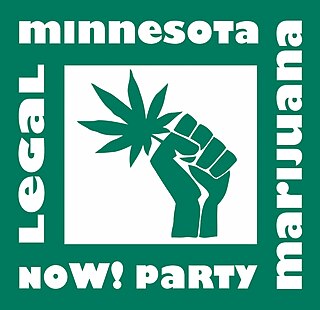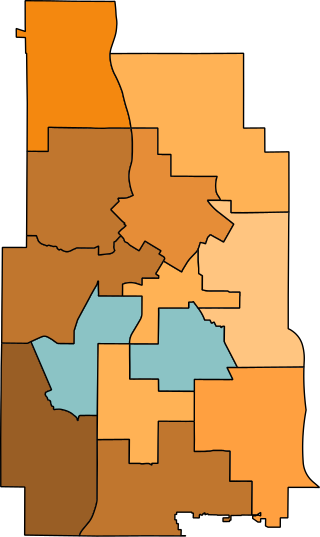The Green Party of the United States (GPUS) is a federation of Green state political parties in the United States. The party promotes green politics, specifically environmentalism; nonviolence; social justice; participatory democracy; grassroots democracy; anti-war; anti-racism; eco-socialism. On the political spectrum, the party is generally seen as left-wing. As of 2023, it is the fourth-largest political party in the United States by voter registration, behind the Libertarian Party.

The Socialist Party USA, officially the Socialist Party of the United States of America, is a socialist political party in the United States. The party was established in 1973 as one of the successors to the Socialist Party of America, which had broken up a year prior, resulting in another group called Social Democrats, USA and the Democratic Socialist Organizing Committee (split).

The Green Party of Oklahoma is a political party in the U.S. state of Oklahoma. It was formed in 2002 through a gradual coalition of various state green groups and received its accreditation from the Green Party of the United States (GPUS) in May 2005. Its stated aims are a commitment to environmentalism, non-violence, social justice, and grassroots democracy.

The Maine Green Independent Party is a state-level political party affiliated with the Green Party of the United States. It is the oldest state green party in the United States. It was founded following an informal meeting of 17 environmental advocates, including Bowdoin College professor John Rensenbrink and others in Augusta, Maine in January 1984. From 1994 to 2006, the party's gubernatorial nominees received between 6% and 10% of the vote.

The Green-Rainbow Party (GRP) is the Massachusetts affiliate of the Green Party of the United States and a political designation in Massachusetts officially recognized by the Secretary of the Commonwealth of Massachusetts. Up until 2020, it was an officially recognized political party in Massachusetts, losing that status as the result of vote tallies in the November 2020 election.

Howard Gresham Hawkins III is an American trade unionist, environmental activist, and perennial candidate from New York. A co-founder of the Green Party of the United States, Hawkins was the party's presidential nominee in the 2020 presidential election. His ideological platform includes enacting an eco-socialist version of the Green New Deal—which he first proposed in 2010—and building a viable, independent working-class political and social movement in opposition to the country's two major political parties, and capitalism in general.

The Green Party of Texas is the state party organization for Texas of the Green Party of the United States. The party was founded as the electoral arm of the political movements for grassroots democracy, social justice, ecological wisdom, and peace/nonviolence. The aim of the movement is to bring change to the Government such that it is brought in line with the Global Greens Charter.

The Green Party of New York is the affiliate of the Green Party of the United States in the U.S. state of New York. It was founded in 1992 and is a part of the Green Party movement. The Party has had ballot access at various points in its history. It regained ballot status for four years when Howie Hawkins received over 50,000 votes in the 2010 gubernatorial election and retained it for another four years in the 2014 election, when the party moved up to line D, the fourth line on state ballots, passing the Working Families and Independence parties, with 5 percent of the vote. It lost its status as a ballot-qualified political party in New York as of November 2020 when the law governing ballot access was changed requiring a larger number of votes in the Presidential and Gubernatorial elections.

The Illinois Green Party is a statewide political party in Illinois. The party is state affiliate of the Green Party of the United States.

Minnesota is known for a politically active citizenry, with populism being a longstanding force among the state's political parties. Minnesota has consistently high voter turnout; in the 2008 U.S. presidential election, 77.8% of eligible Minnesotans voted – the highest percentage of any U.S. state or territory – versus the national average of 61.7%. This was due in part to its same day voter registration laws; previously unregistered voters can register on election day, at their polls, with evidence of residency.

The District of Columbia holds general elections every two years to fill various D.C. government offices, including mayor, attorney general, members of the D.C. Council, members of the D.C. State Board of Education, and members of its Advisory Neighborhood Commissions. Special elections may be held to fill vacancies at other points in time. Additionally, citywide ballot measures may be proposed and voted on.

The 2013 Minneapolis mayoral election was held on November 5, 2013, to elect the mayor of Minneapolis for a four-year term. This was the second mayoral election in the city's history to use instant-runoff voting, popularly known as ranked choice voting, first implemented in the city's 2009 elections. Municipal elections in Minnesota are nonpartisan, although candidates are able to identify with a political party on the ballot. After incumbent Mayor R. T. Rybak announced in late 2012 that he would not seek a fourth term, 35 candidates began campaigns to replace him. Many of these candidates sought the endorsement of the Minneapolis unit of the Minnesota Democratic–Farmer–Labor Party (DFL), though the convention ultimately ended with no endorsement.

Minnesota Legal Marijuana Now is a political third party in the U.S. state of Minnesota established in 1998 to oppose drug prohibition.

The 2020 Green National Convention (GNC) or presidential nominating convention was an event in which delegates of the Green Party of the United States (GPUS) chose its nominees for president and vice president in the 2020 U.S. presidential election. The convention was originally scheduled to be held July 9–12, 2020, at Wayne State University in Detroit, Michigan, but it was decided to instead hold the convention online due to the COVID-19 pandemic.
A general election was held in the U.S. state of Minnesota on November 3, 2020. All seats in the Minnesota Senate and Minnesota House of Representatives were up for election as well as several judicial seats, Minnesota's 10 presidential electors, a United States Senate seat, Minnesota's eight seats in the United States House of Representatives, and several positions for local offices. A primary election to nominate major party candidates and several judicial and local primary elections were held on August 11, 2020.

A mayoral election was held on November 2, 2021, to elect the mayor of the U.S. city of Minneapolis. Incumbent DFL mayor Jacob Frey won reelection to a second term, becoming the first Minneapolis mayor to win a second term since R. T. Rybak in 2005. Minneapolis mayoral elections use instant-runoff voting, also known as ranked-choice voting. All candidates appear on the same ballot and there is no primary election, nor is there a runoff. Minneapolis's twin city, Saint Paul, also held a mayoral election on the same day, using the same system.

Timothy A. Davis is an American cannabis rights activist, cyclist, gardener, politician, writer, retired warehouse laborer, and disc jockey. A founding member of the Grassroots Party in 1986, Davis was their candidate for Minnesota Lieutenant Governor in 1994, and United States Senator in 1996 and 2012.
A general election was held in Minneapolis on November 2, 2021. Minneapolis's mayor was up for election as well as all the seats on the City Council, the two elected seats on the Board of Estimate and Taxation, and all the seats on the Park and Recreation Board. Voters were able to rank up to three candidates for each office in order of preference. Additionally, there were three ballot measures on the ballot related to government structure, public safety, and rent control.

The 2023 Minneapolis City Council election took place in the city of Minneapolis, Minnesota, United States on November 7, 2023. The Minneapolis City Council is made up of 13 members serving four-year terms, with one council member representing each of the city's 13 wards. The 2023 election was the first election since the city's form of government moved to an Executive Mayor-Legislative Council structure. The change was prompted after voters narrowly approved a ballot measure in 2021 to shift certain powers from the city council to the mayor. Topics surrounding public safety, affordable housing, rent control, and racial justice were at the forefront of the campaign.

Cannabis political parties of Minnesota include the Grassroots—Legalize Cannabis Party, the Independence Party, and the Legal Marijuana Now Party. Also, both the Libertarian Party and the Green Party advocate for the legalization of marijuana.

















